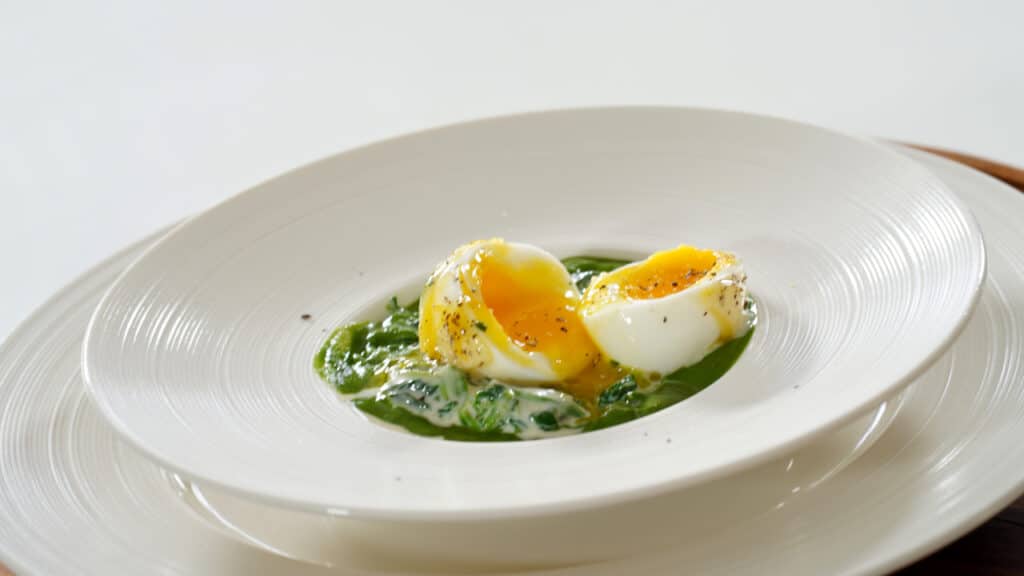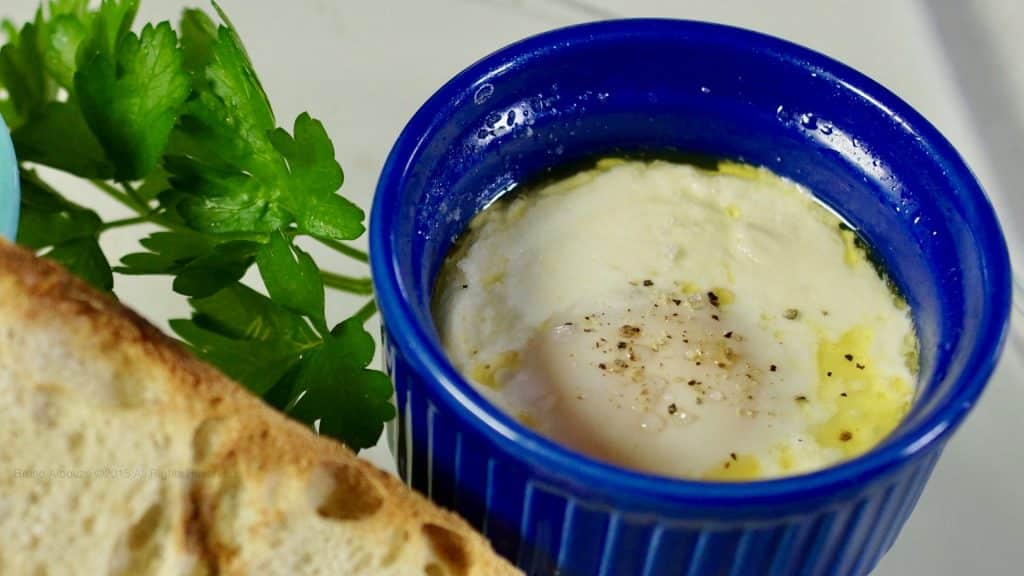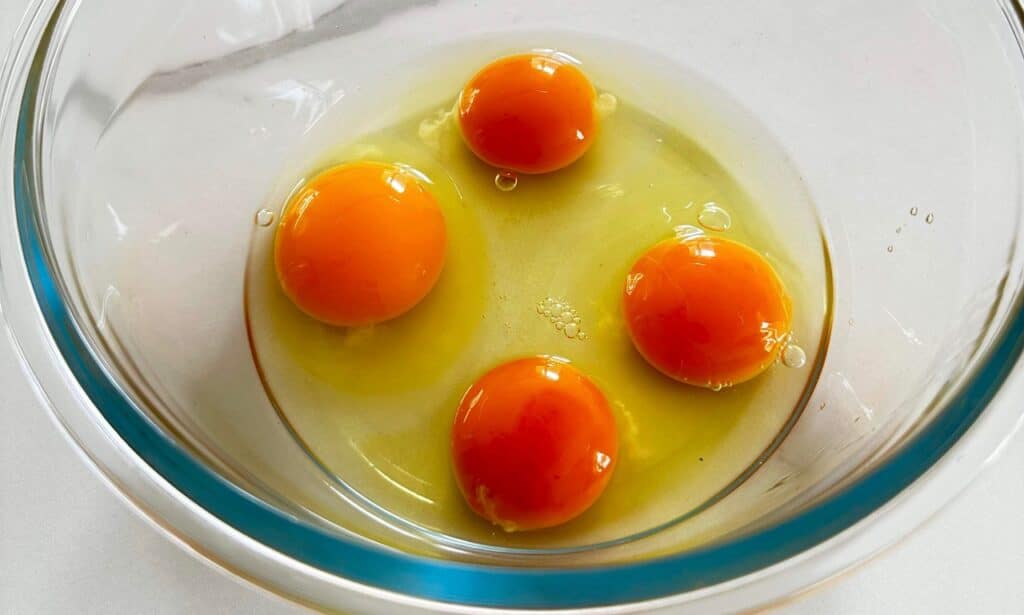
How to choose Eggs?
There are several factors to consider when selecting eggs, such as size, color, and freshness. Let’s explore the key points to keep in mind when choosing eggs for your next culinary masterpiece. Size: Eggs come in various sizes, including small, medium, large, extra-large, and jumbo. The size of the egg can affect the amount of ingredients needed for a recipe, so it’s important to choose the size specified in the recipe for the best results. In general, large eggs are the standard size used in most recipes unless otherwise indicated (≈55g). Color: The color of the eggshell can vary depending on the breed of the hen that laid the egg. While white and brown eggs are the most common, the color of the eggshell does not affect the taste or quality of the egg. However, some people believe
that brown eggs are more natural or organic, which is not necessarily true. The color of the eggshell is simply a result of the breed of the hen. Freshness: Fresh eggs are crucial for baking and cooking, as they can affect the texture and flavor of the final dish. To determine the freshness of an egg, you can perform a simple test. Fresh eggs feel heavy. Place the egg in a bowl of water – if it sinks and lies flat on the bottom, it is fresh. If it stands upright on the bottom, it is still good to eat but should be consumed soon. If it floats to the top, it is no longer fresh and should be discarded.
How to store Eggs?
Storing eggs properly is key to maintaining their freshness and quality. Whether you buy them from a grocery store or collect them fresh from your own chickens, knowing how to store eggs correctly will ensure that they stay in top condition for as long as possible. One important factor to keep in mind is that eggs have a natural protective coating c
alled the bloom, which helps to seal the pores in the eggshell and prevent bacteria from entering the egg. To preserve this protective layer, it is advisable not to wash eggs unless you are ready to use them immediately. When it comes to storing eggs, the best place is in the refrigerator or in dry storage. I remember when I was apprentice, eggs were stored at room temperature as all recipes call for room temp eggs. Also, eggs were delivered twice a week. It is recommended to store eggs in their original carton, with the large end up to help keep the yolk centered.
How to cook eggs?
There are numerous ways to cook eggs, each producing a different texture and flavor. Let’s explore some popular methods for cooking eggs that will elevate your dishes to the next level:
Hard-boiled and soft-boiled eggs are classic breakfast options that are easy to make.

Scrambled eggs are a quick and simple dish that can be enjoyed for breakfast, brunch and lunch: Scrambled Egg Basquaise Recipe.

Fried eggs, sunny side up eggs are a delicious addition to many dishes, such as burgers, sandwiches, or salads. Croque Madame Recipe

Baked eggs are a delicious and easy way to cook eggs for a crowd. You can bake eggs in individual ramekins with toppings like cheese, ham and cream.

Eggs are a versatile and nutritious ingredient used in a wide range of culinary creations. From fluffy omelet
tes to decadent cakes, eggs play a crucial role in countless recipes. But did you know that there are actually various types of eggs beyond the traditional chicken egg? Among the most common types of eggs are chicken eggs, duck eggs, and quail eggs, each offering a unique flavor and texture profile to dishes.
-
- Chicken eggs, the classic choice, are loved for their rich yolk and mild taste, making them a staple in both sweet and savory recipes.
- Duck eggs, on the other hand, are prized for their larger size and richer flavor, perfect for adding a luxurious touch to baked goods or custards.
- Quail eggs, tiny in comparison, are delicate and flavorful, often showcased as bite-sized appetizers or garnishes.
Whether you’re a fan of the familiar chicken egg or looking to explore the world of alternative eggs, there’s a perfect choice for every culinary adventure. If you’ve always wanted to incorporate eggs into your daily meals but weren’t sure about their nutritional value, it’s time to go on. These powerhouse nutrients help support our immune system, promote healthy vision, and contribute to overall good health. Another key ingredient found in eggs is choline. Choline is essential for brain health, as it helps in the development and function of our brain cells. It also aids in liver function and plays a role in preventing certain types of birth defects. But that’s not all! Eggs contain healthy fats, including omega-3 fatty acids. These fats are known for their heart-healthy benefits, contributing to lowered cholesterol levels and reduced risk of heart disease. Additionally, eggs are low in carbohydrates, making them a suitable choice for those following a low-carb or keto diet.
From classic omelettes to silky scrambled eggs, and sunny side up eggs, in my blog, you’ll discover exciting ways to transform this humble ingredient into a culinary masterpiece.
Do you (really) know eggs?
There are several misconceptions about eggs that often make it difficult to choose. Especially, when there are so many varieties of eggs to choose from! Here’s a list of eggs, their types and nutrition levels.
Furthermore, people have different health concepts in terms of egg yolks, about its fats and cholesterol content. Let’s explore the different types of eggs and their nutritional values. And, to do that, more highlights should be put on the different types of chicken eggs – which are most common in our regular diets.
Chicken eggs are the most common and widely consumed form of egg. There are two different types of chicken eggs – white and brown, depending on the breed. There are several varieties of eggs, which are all rich in protein, vitamins, calcium, zinc and other healthy minerals. The size of the eggs can vary with the breed, age and weight of the hen.
Conventional eggs come from hens which are generally home-reared. These hens mostly feed on grain-based food, supplemented with vitamins and minerals.
Though the duck eggs are almost similar to the chicken eggs, they have bigger yolks and are rich in healthy fats, cholesterol, protein and vitamin B, D and E; making them healthier than the chicken eggs. Duck eggs work wonders in improving vision, skin and hair, and also prevent several types of cancer, heart and liver diseases and immunity disorders.
Turkey eggs are not readily available as the chicken eggs. These eggs pack a powerful punch, providing a whopping 50 times more calories, fat, vitamins, and minerals compared to traditional chicken eggs. Turkey eggs are not just delicious; they are also a powerhouse of nutrients that support muscle growth, promote skin health and vision, boost memory and immunity, slow down the aging process, and even lower the risk of degenerative nervous disorders.
Twice in size as much as the chicken eggs, the goose eggs are heavier and contain 20 percent more protein with an abundance of calcium, phosphorus and zinc complex vitamins.
Ostrich eggs are the heaviest of all; about twenty times heavier than the chicken eggs. A single ostrich egg is loaded with 2000 calories and has similar protein and fat content as the chicken eggs. Mostly these eggs are used for fertility treatment and decoration rather than consumed as food.
Hens in this context are allowed to freely eat plants, insects, worms and some commercial feed.
The hens producing such eggs are mostly conventional, except for the fact that they are fed with supplements rich in certain nutrients.
Though chicken eggs are widely popular, there are other types of edible bird eggs which are also enriched with nutritional value and taste.
Quail egg, produced by the quail bird are lighter and smaller than the chicken eggs and possess more nutritional value. It has 13% more protein than recommended daily allowance, vitamin B complex, thiamine, vitamin B1, and vitamin D.
Quail eggs are often served for appetizers or amuse-bouche into devil eggs and blinis.
Different labels = different eggs

In recent years, the term “pasture-raised” has gained popularity, offering a new option for consumers seeking high-quality eggs. However, not all pasture-raised eggs are equal, and the level of animal care can vary significantly between farms. This variability highlights the importance of transparency in sourcing ingredients and the need for consumers to be informed about where their food comes from. Jeff Hinds, the vice president of quality assurance, compliance, and food safety at Vital Farms, emphasizes the importance of aligning marketing terms with the actual farming practices. Consumers are becoming more discerning and are seeking authenticity in the products they purchase.
As a chef, it’s crucial to partner with suppliers who uphold high standards of animal welfare and ethical farming practices. Visiting farms, like the sponsored tour I recently participated in at Vital Farms, can provide valuable insights into the source of ingredients. By seeing firsthand how hens are raised and the conditions they are kept in, chefs can make more informed decisions about the products they use in their recipes. This level of transparency can also be a selling point for restaurants looking to attract socially conscious consumers. Incorporating pasture-raised eggs into culinary creations not only elevates the quality of the dish but also aligns with a commitment to sustainability and ethical sourcing.

As consumer demand for transparency continues to rise, chefs have the opportunity to lead the way in promoting responsible food practices and showcasing the benefits of supporting farms that prioritize animal welfare. By understanding the differences between various egg labeling terms and actively seeking out ingredients from reputable sources, chefs can demonstrate their dedication to quality, authenticity, and sustainability. Embracing pasture-raised eggs is not just a culinary choice; it’s a statement of values that resonates with today’s conscientious diners.
Caged: Hens are confined to cages with a 67-square inch space each. They never see the light of day and consume a corn or soy diet. Over 90 percent of eggs in the U.S come from hens that are kept in cages for their entire egg-laying lives.
Cage-Free: These ladies have more room than caged hens, since each is given less than 1 square foot. Still, they’re not entirely “free,” since they’re confined to barns and consume a corn or soy diet.
Free-Range: Allotted less than 2 square feet per hen, these animals have more space than their caged and cage-free peers, but they don’t get outdoors as much as you may think. Some seldom get to see the light of day and many eat a corn- or soy-based feed.
Pasture-Raised: Huns are given at least 108 square feet each and consume some feed and lots of grass, bugs, worms and anything else they can find in the dirt. They tend to be let out of the barns early in the morning and called back in before nightfall.
Pasture-Raised Eggs: Why They’re Worth It When it comes to eggs, not all are created equal. Pasture-raised hens have been shown to produce eggs that are not only healthier but also more environmentally friendly. A 2003 study from Pennsylvania State University revealed some fascinating findings: compared to eggs from hens raised on traditional feed, pasture-raised eggs contain twice as much omega-3 fat, three times more vitamin D, four times more vitamin E, and seven times more beta-carotene. From an agricultural perspective, pasture-raised eggs offer additional benefits. With hens grazing, managing their own feed, and spreading their own manure, farmers have less work and require fewer resources and equipment. This natural approach to egg production also ensures that the hens lead a more fulfilling and happy life. However, not all pasture-raised eggs meet the same high standards.
Which country consumes the most eggs?
China ranked the highest in egg consumption per capita with 22.0 kg followed by Mexico and Japan. There are lots of people who enjoy consuming eggs, but there is one country that consumes more eggs than just about any other place on Earth. Per person, Japan consumes the most eggs every year. The average person in Japan eats about 320 eggs per year. That is almost one egg per day.
